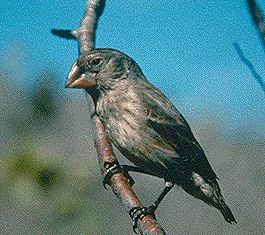Quantitative genetics - What has driven the evolution of beak sizes in Darwin's finches?

Darwin's finches
Fourteen species of Darwin's finches live in the Galapagos archipelago, and many of them differ most obviously in the sizes and shapes of their beaks. A finch's beak shape influences how efficiently it can feed on different types of food. The best evidence for this comes from a comparison of two species, the large-beaked Geospiza magnirostris and the smaller G. fortis , feeding on the same kind of hard fruit.
• G. magnirostris (pictured opposite) has a large beak and can crack the fruit (called the mericarp) in only 2 seconds, exerting an average force of 26 kgf; it can then easily, in about 7 seconds, eat all the four to six seeds of the smashed fruit.
• G. fortis are smaller and not strong enough to crack mericarps. Instead, they twist open the lower surface, applying a force of only 6 kgf and taking 7 seconds to reach the seeds inside; but only one or two of the seeds can be obtained in this way and it takes an average of 15 seconds to extract them.
Smaller finches are probably more efficient with smaller types of food, but this is more difficult to show. Both large and small finches on the Galapagos do in fact eat small seeds, though there is an indirect reason (as we shall see) to believe that smaller finches do so more efficiently.
| Next |



